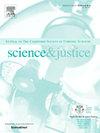The persistence of fibres following a choreographed assault: A quantitative assessment of the influence of physical activity
IF 1.9
4区 医学
Q2 MEDICINE, LEGAL
引用次数: 0
Abstract
The persistence of textile fibres is influenced by activities undertaken by the wearer; however, few studies have exclusively explored this relationship. This study extends the authors’ work described in a previous publication on fibre transfer and aimed to address this gap by investigating the short- to medium-term persistence of textile fibres on a cotton T-shirt and polyester/cotton hoody worn by a ‘victim’ and ‘assailant’ transferred following a typical assault scenario. The number, length and spatial distribution of fibres recovered at intervals up to four hours was examined. Furthermore, the influence of performing physical activity of varying intensity on persistence behaviour was investigated.
Results showed that retentive capacity of the recipient textile bears a strong impact on fibre recovery, highlighting two distinct trends. Persistence of cotton and man-made fibres from donor hoodies recovered from T-shirts generally decreased as intensity of activity increased. In contrast, retention of T-shirt cotton on recipient hoodies appeared greatest after high intensity activity (77.5%). The confounding increased recovery in the initial hour (161.8%) indicated the important contribution of fragmentation and attributes of the donor fibre, in addition to physical activity, on persistence. The proportion of shorter fibres generally increased with time and intensity of activity. Crucially, physical activity was more strongly associated with fibre length than quantity of fibres recovered, which has potential implications on evidential value in practice.
The overall project aim was to strengthen the current understanding of fundamental mechanisms implicated in fibre transfer and persistence. This ultimately can be used to inform and support examiners to evaluate fibre findings at the activity level, thereby enhancing the contribution to the judicial system.
经过精心设计的攻击后纤维的持久性:体育活动影响的定量评估
纺织纤维的持久性受到穿着者所进行的活动的影响;然而,很少有研究专门探讨这种关系。这项研究扩展了作者在之前关于纤维转移的出版物中所描述的工作,旨在通过调查在典型的攻击场景后转移的“受害者”和“攻击者”所穿的棉t恤和聚酯/棉卫衣上的纺织纤维的中短期持久性来解决这一差距。每隔4个小时就检查回收的纤维的数量、长度和空间分布。此外,进行不同强度的体力活动对坚持行为的影响进行了调查。结果表明,接收纺织品的保留能力对纤维的恢复有很强的影响,突出了两个明显的趋势。从t恤中回收的捐赠帽衫中棉和人造纤维的持久性一般随着活动强度的增加而减少。相比之下,高强度运动后,受训者卫衣上t恤棉的保留率最高(77.5%)。最初一小时的恢复增加(161.8%)表明,除了体力活动外,供体纤维的碎片和属性对持久性有重要贡献。短纤维的比例通常随着运动时间和强度的增加而增加。至关重要的是,体育活动与纤维长度的关系比恢复纤维的数量更密切,这在实践中具有潜在的证据价值。整个项目的目的是加强目前对涉及纤维转移和持久性的基本机制的理解。这最终可用于通知和支持审查员在活动一级评价纤维调查结果,从而加强对司法系统的贡献。
本文章由计算机程序翻译,如有差异,请以英文原文为准。
求助全文
约1分钟内获得全文
求助全文
来源期刊

Science & Justice
医学-病理学
CiteScore
4.20
自引率
15.80%
发文量
98
审稿时长
81 days
期刊介绍:
Science & Justice provides a forum to promote communication and publication of original articles, reviews and correspondence on subjects that spark debates within the Forensic Science Community and the criminal justice sector. The journal provides a medium whereby all aspects of applying science to legal proceedings can be debated and progressed. Science & Justice is published six times a year, and will be of interest primarily to practising forensic scientists and their colleagues in related fields. It is chiefly concerned with the publication of formal scientific papers, in keeping with its international learned status, but will not accept any article describing experimentation on animals which does not meet strict ethical standards.
Promote communication and informed debate within the Forensic Science Community and the criminal justice sector.
To promote the publication of learned and original research findings from all areas of the forensic sciences and by so doing to advance the profession.
To promote the publication of case based material by way of case reviews.
To promote the publication of conference proceedings which are of interest to the forensic science community.
To provide a medium whereby all aspects of applying science to legal proceedings can be debated and progressed.
To appeal to all those with an interest in the forensic sciences.
 求助内容:
求助内容: 应助结果提醒方式:
应助结果提醒方式:


